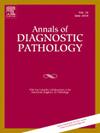Assessing the predictive value of Ki-67 and progesterone receptor algorithms for recurrence and disease-free survival in meningiomas
IF 1.4
4区 医学
Q3 PATHOLOGY
引用次数: 0
Abstract
Sophisticated refinements in histopathology are evolving to improve meningioma outcome prediction. The aim of this study is to evaluate the stand-alone performance of Ki-67 and progesterone receptor (PR) algorithm scores in meningiomas and their power in predicting recurrence and disease-free survival of the patients.
Whole slide images of Ki-67 and PR-stained slides from 404 meningioma cases were analyzed by a digital image viewer and analysis software Virapath-2.1, which analyzes the tumor cells by size, color, and shape. Ki-67 scores were calculated in the hotspot region that contains at least 1000 tumor cells, while PR was calculated on the whole slide. The results were compared with WHO grade, tumor recurrence and disease-free survival (DFS).
Mean Ki-67 scores were 4.2 ± 3.5, 12.1 ± 10.6 and 22. ± 8.5 for grade 1, 2 and 3 tumors (p < 0.05), while PR scores were 49 ± 35, 43 ± 34 and 16 ± 30, respectively (p > 0.05). Median survival of patients based on Ki-67 values ≤13.2 % and > 13.2 % was 122 versus 60 months (p = 0.004). Prediction of recurrence based on Ki-67 score was found to have acceptable discrimination (AUC = 0.74). PR expression was not found to correlate with DFS, but recurrent tumors had lower PR scores than non-recurrent tumors (31.3 ± 33.8 vs. 49.0 ± 33.0; p = 0.03).
Elevated Ki-67 levels identified by the algorithm may classify meningioma patients at high recurrence risk and inform clinical management. Although PR scores did not correlate with DFS, lower expression in recurrent tumors suggests a role in recurrence risk assessment. Larger prospective studies are needed for routine clinical practice.
评估Ki-67和孕激素受体算法对脑膜瘤复发和无病生存的预测价值。
精密的组织病理学正在发展,以提高脑膜瘤的预后预测。本研究的目的是评估Ki-67和孕激素受体(PR)算法评分在脑膜瘤中的独立表现及其预测患者复发和无病生存的能力。404例脑膜瘤Ki-67全片和pr染色全片采用数字图像查看器和分析软件Virapath-2.1对肿瘤细胞的大小、颜色和形状进行分析。Ki-67评分在肿瘤细胞不少于1000个的热点区域计算,PR在整个切片上计算。将结果与WHO分级、肿瘤复发率和无病生存期(DFS)进行比较。Ki-67平均评分分别为4.2±3.5、12.1±10.6和22分。1、2、3级为±8.5 (p < 0.05)。Ki-67≤13.2%和> 13.2%患者的中位生存期分别为122个月和60个月(p = 0.004)。基于Ki-67评分的复发预测具有可接受的判别性(AUC = 0.74)。PR表达与DFS无相关性,但复发肿瘤的PR评分低于非复发肿瘤(31.3±33.8∶49.0±33.0;p = 0.03)。通过该算法检测到的Ki-67水平升高可以对脑膜瘤高复发风险患者进行分类,并为临床管理提供信息。虽然PR评分与DFS无关,但在复发肿瘤中较低的表达提示其在复发风险评估中的作用。常规临床实践需要更大规模的前瞻性研究。
本文章由计算机程序翻译,如有差异,请以英文原文为准。
求助全文
约1分钟内获得全文
求助全文
来源期刊
CiteScore
3.90
自引率
5.00%
发文量
149
审稿时长
26 days
期刊介绍:
A peer-reviewed journal devoted to the publication of articles dealing with traditional morphologic studies using standard diagnostic techniques and stressing clinicopathological correlations and scientific observation of relevance to the daily practice of pathology. Special features include pathologic-radiologic correlations and pathologic-cytologic correlations.

 求助内容:
求助内容: 应助结果提醒方式:
应助结果提醒方式:


